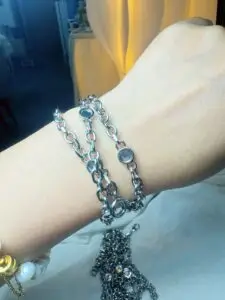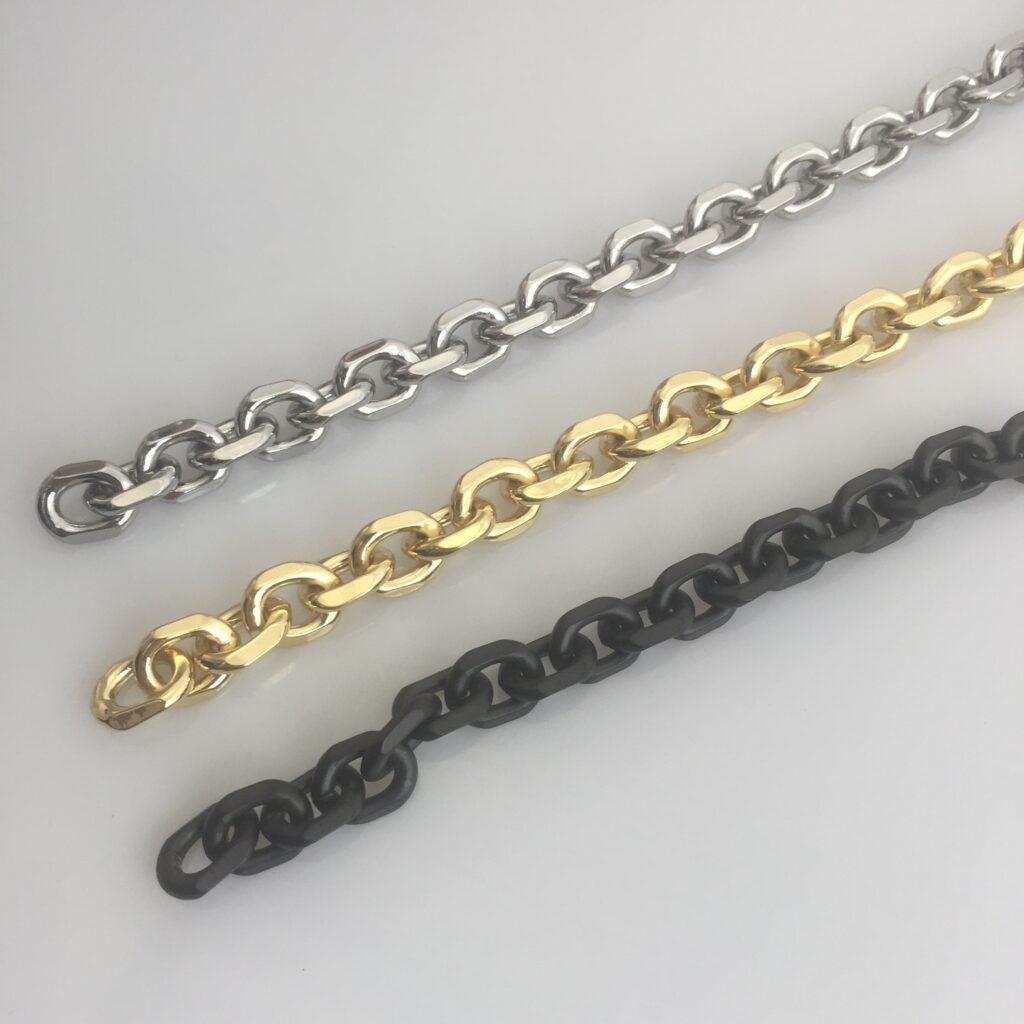Classification and Application Analysis of Hardware Luggage Accessories Chains: A Comprehensive Guide from Materials to Scenarios
In luggage hardware accessories, chains serve as core components that combine functionality and aesthetics, showcasing diversified classification systems and application scenarios. This article systematically analyzes hardware luggage chains’ classification logic and application directions from three dimensions: materials, structure, and industry trends, providing a practical guide for industry practitioners and consumers.

I. Material Classification: Dual Expression of Performance and Aesthetics
1. Metal Chain Family
- Iron Chains
Forged or cast from carbon steel or alloy steel, iron chains excel in high strength and low cost. Their rugged, industrial texture makes them standard equipment for casual backpacks and workwear bags. However, attention should be paid to rust prevention to avoid dullness caused by oxidation. - Alloy Chains
Produced by mixing metals such as copper, zinc, and aluminum, alloy chains offer excellent toughness and corrosion resistance. High-end luggage brands often employ copper alloy chains, which can present fashionable colors like rose gold and gunmetal gray through electroplating or PVD treatment, creating a texture contrast with the leather of luxury bags. - Stainless Steel Chains
Made from 304/316L stainless steel, these chains possess salt spray and oxidation resistance, making them suitable for outdoor mountaineering bags and travel suitcases. Some brands utilize vacuum ion plating technology to coat the stainless steel surface with a titanium layer, preserving metallic luster while enhancing wear resistance. - Hand-Woven Chains
Crafted from fine metal wires through traditional weaving techniques, these chains feature delicate textures and flexible shapes as design highlights. Italian brand Bottega Veneta’s woven chain handbags create a浮雕-like three-dimensional effect through variations in chain link density.
2. Non-Metallic Innovative Materials
- Leather Chains
Constructed from top-layer cowhide or crocodile-patterned embossed leather, connected via rivets or metal fasteners. Hermès’ Kelly bag chain straps exemplify French elegance through hand-sewn combinations of leather and metal rings. - Engineering Plastic Chains
Ultra-high molecular weight polyethylene (UHMW-PE) chains stand out for their lightweight and impact resistance, commonly used in sports brand backpacks. An outdoor brand has introduced detachable plastic chains with quick-release fasteners, enabling swift switching between single shoulder and crossbody modes. 
II. Structural Types: Evolution from Industrial Transmission to Fashion Decoration
1. Basic Structural Classifications
- Roller Chains
Composed of chain plates, pins, bushes, and rollers, commonly found in mechanical equipment transmission systems. In luggage, they are often used in the telescoping handles of travel suitcases, with increased roller diameters enhancing load-bearing capacity. - Silent Chains (Tooth Chains)
Meshing toothed chain plates with pins, these chains operate with low noise and are suitable for high-end business briefcases. German brand Rimowa’s aluminum-magnesium alloy suitcases employ tooth chain drive wheel sets to ensure smooth and silent case opening and closing. - Hauling Chains
Circular chain structures paired with high-strength steel materials, used in lifting equipment. Some custom travel suitcases utilize miniature hauling chains as locking mechanisms, achieving press-type quick opening and closing.
2. Specialty Chains
- Stepless Speed-Change Chains
Designed with a variable pitch to achieve stepless adjustment of chain length. Japanese brand Porter’s adjustable shoulder straps utilize this technology to allow users to fine-tune chain length according to height. - Protective Drag Chains
Formed by densely packed chain links into tubular shapes, used to protect cables or hoses. In smart luggage, this structure is innovatively applied to hidden charging cable storage systems.
III. Industry Trends: Dual Drive of Technological Innovation and Market Demand
1. Material Technology Upgrades
- Application of New Alloys
Titanium alloy chains surpass traditional stainless steel in specific strength (strength-to-density ratio) and are used in extreme sports equipment bags. A mountaineering brand’s titanium alloy ice axe bag features chains with a load-bearing capacity of 50kg and a self-weight of only 80g. - Breakthroughs in Eco-Friendly Materials
Bio-based nylon chains, derived from castor oil, reduce carbon emissions by 60%. Swedish brand Fjällräven has adopted such chains in its eco-friendly backpack series.
2. Production Process Evolution
- 3D Printing Customization
German EOS metal 3D printing technology enables the manufacture of hollow-structure chains with 0.1mm precision. A luxury brand has launched a limited-edition 3D-printed chain handbag, with each chain link internally engraved with the brand’s DNA pattern. - Nanocoating Technology
DLC (diamond-like carbon) coatings enhance chain surface hardness to HV2000, improving wear resistance by 5 times. Tumi has applied this technology to chain components in its business cases, claiming they can withstand 100,000 opening and closing tests. 
3. Market Consumption Insights
- Personalized Customization
Gen Z consumers are driving demand for “one chain, multiple wears,” with significant growth in the detachable chain component market. Data from a domestic e-commerce platform shows that modular chain bag sales in Q1 2025 increased by 180% year-on-year. - Integration of National Trend Culture
The Palace Museum Cultural and Creative’s “Palace Gate” series chain bags combine traditional lock elements with alloy chains, with the first month sales of a single model exceeding 10,000 units.
IV. Application Scenarios: Balancing Functional Needs and Design Aesthetics
| Scenario | Recommended Chain Type | Core Needs | Case Reference |
|---|---|---|---|
| Business Briefcase | Copper Alloy Silent Chain | Silence/Texture | Montblanc Meisterstück Series |
| Travel Suitcase | Stainless Steel Roller Chain | Load-Bearing/Corrosion Resistance | Samsonite Cosmolite Series |
| Fashion Handbag | Hand-Woven Chain + Leather | Decorative | Bvlgari Serpenti Series |
| Sports Backpack | Engineering Plastic Chain | Lightweight/Impact Resistance | Arc’teryx Aerios Series |
| Smart Luggage | Miniature Hauling Chain | Precision Transmission | Away Smart Luggage |
Conclusion
As key components connecting functionality and aesthetics, hardware luggage chains have evolved beyond traditional material dimensions, delving into structural innovation, material technology, and cultural integration. For the industry, grasping the three major trends of lightweight, customization, and intelligence, and integrating material performance with user experience, is crucial for breaking through homogeneous competition. For consumers, understanding chain classification logic allows for more precise matching of usage needs and aesthetic preferences, making each chain a fashionable statement of individuality.


